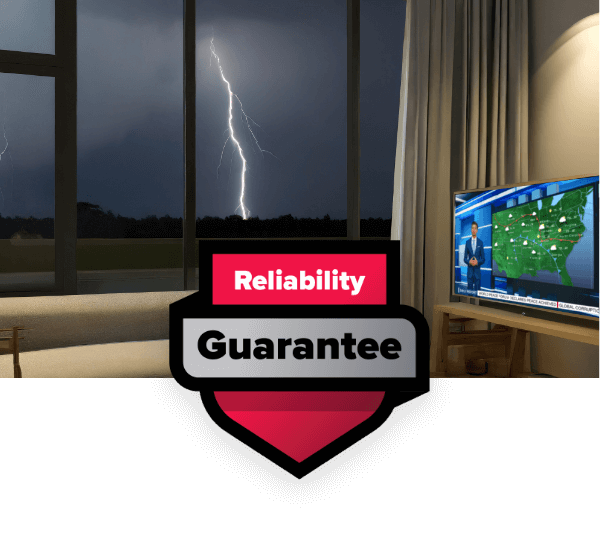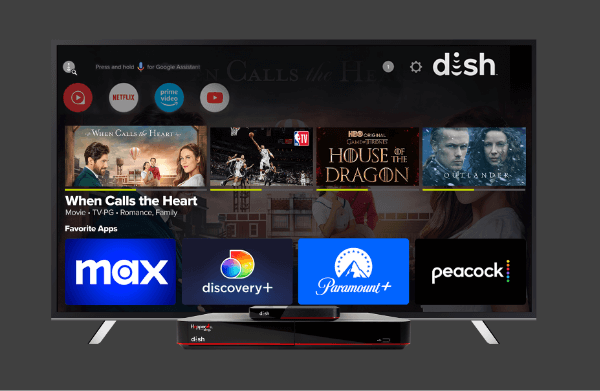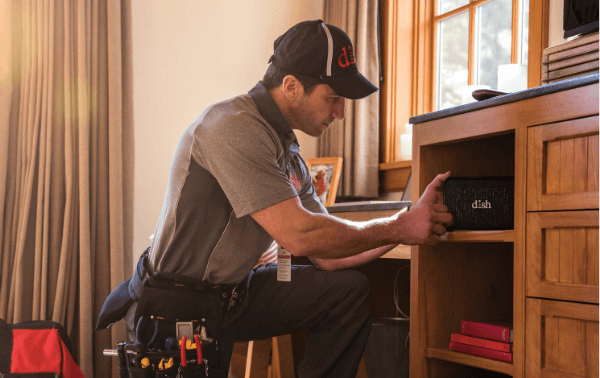Here’s How Weather-Resistant Fiber Internet Conquers Storms
Table of Contents
Have you ever been in the middle of a vital video meeting when the skies darken, thunder crashes, and your internet connection flickers and dies? It’s a frustratingly common scenario that leaves many of us wondering—is there a more reliable option out there? As extreme weather events become increasingly common across America, the quest for weather-resistant internet has become prominent.
Enter weather-resistant fiber internet, famous for its severe weather withstanding capabilities. But how well does it withstand Mother Nature’s fury? Is it truly the knight in shining armor for your connectivity needs during storms, snow, extreme temperatures, and power outages? Let’s discuss.
How Fiber Internet Technology Works
We first need to examine its fundamental technology to understand why fiber internet exhibits such impressive weather resistance. Unlike traditional copper-based systems, fiber optic internet transmits data through thin strands of glass or plastic in the form of light pulses.
The Light-Based Technology Advantage
The core difference between fiber and other internet types lies in what’s traveling through the cables. Traditional copper-based internet infrastructure uses electrical signals to transmit data, making it vulnerable to interference from various sources, including weather events. In contrast, fiber uses light to carry information, which provides inherent advantages in challenging conditions.
When data is transmitted via light pulses rather than electricity, it becomes immune to many environmental factors that plague other internet types. Since fiber optic cables are made of glass rather than metal, they aren’t affected by electromagnetic interference from nearby power lines, electrical equipment, or lightning storms.
Underground Installation
One of the most significant reasons fiber internet maintains reliability during adverse weather is its typical installation method. Fiber optic cables are often buried underground, providing a protective barrier against surface-level weather events. This strategic placement shields the infrastructure from:
- High winds that can knock down above-ground lines
- Falling trees and branches during storms
- Ice and snow accumulation that can weigh down and break cables
- Flooding (when properly sealed)
- Lightning strikes
The underground installation creates a protective environment that maintains a relatively stable temperature compared to the sometimes extreme fluctuations above ground. This helps fiber maintain performance during both freezing winters and scorching summers.
Physical Composition and Durability
Fiber cables themselves are engineered to withstand challenging conditions. The typical fiber cable consists of incredibly thin glass strands (about the width of a human hair) wrapped inside a thicker cladding, which is then housed inside a protective buffer layer. This multi-layered construction creates significant protection against various environmental threats.
The physical composition of fiber cables provides:
- Resistance to water damage
- Protection against temperature fluctuations
- Flexibility that allows for some ground movement without breaking
- Immunity to corrosion (unlike metal-based cables)

How it performs
Weather-Resistant Fiber Internet vs The Elements
Now that we understand the technology behind fiber internet’s resilience, let’s examine how it withstands specific weather challenges that commonly disrupt internet service.
Rain and Thunderstorms
Traditional internet connections often experience problems during heavy rain and thunderstorms. Does fiber internet suffer the same fate?
For fiber connections, rain alone typically won’t interrupt service, as fiber optic cables are not affected by water in the way that electrical connections can be. The light signals traveling through fiber cables don’t experience the same degradation as electrical signals when moisture is present.
During thunderstorms, the primary concern is lightning strikes. Here again, fiber has an advantage. Since glass doesn’t conduct electricity, direct lightning strikes to buried fiber lines are much less problematic than they would be for copper-based systems. However, if lightning strikes equipment connected to your fiber network, such as power supplies or routers, those components could still be damaged.
Snow and Ice
Winter weather presents unique challenges for internet infrastructure. Heavy snow accumulation and ice formation can physically damage above-ground cables through weight and expansion/contraction cycles.
Fiber internet tends to be highly reliable during winter weather events because the cables are often underground, protecting them from snow and ice buildup. Even when fiber lines are installed above ground, their lightweight design reduces the risk of sagging and breaking under heavy snow loads.
In extremely cold temperatures, fiber maintains its performance better than copper alternatives. Unlike copper cables that can become brittle and susceptible to damage in freezing conditions, fiber optic lines function normally even in sub-zero temperatures.
High Winds and Storms
Severe storms with high winds are among the most destructive forces for internet infrastructure. Traditional above-ground cables and satellite dishes are particularly vulnerable to wind damage.
In regions prone to hurricanes, tornadoes, or severe windstorms, buried fiber optic cables provide a significant advantage. They remain safely below ground, away from flying debris and falling trees that typically cause outages in copper-based systems.
While fiber is generally less susceptible to storm damage, severe weather events can still impact service in rare cases if they cause extensive infrastructure damage. For instance, outages can still occur if a significant storm damages a central distribution facility or power equipment that supports the fiber network.
Extreme Heat
Summer heat waves can wreak havoc on electronic equipment and infrastructure. How does fiber compare to other internet types in these conditions?
Fiber optic cables are remarkably resistant to heat-related issues. Because fiber doesn’t carry electricity, it doesn’t generate heat during operation like copper cables do, which helps prevent overheating problems during temperature spikes.
Additionally, the underground installation that many fiber networks employ provides natural insulation against extreme surface temperatures. This stable environment helps maintain consistent performance even during the hottest summer days.

Fiber’s Achilles’ heel
The Power Outage Factor
While fiber internet shows impressive resilience against most weather conditions, one weather-related challenge affects all internet types: power outages. So, how does fiber internet fare when the electricity goes out?
The Electricity Dependency
Despite fiber optic cables themselves not requiring electricity to transmit data (they use light), the overall fiber internet system still depends on electrical power at several points:
Fiber optic networks include active components that require electricity, such as routers, switches, and amplifiers. These devices manage the transmission of data signals throughout the network.
Additionally, the equipment in your home that converts the optical signals to usable internet (typically an Optical Network Terminal or ONT) requires electricity to operate, as does your router and other networking equipment.
Backup Power Solutions
Service providers often equip their central facilities with generators for longer-term power during extended outages. This helps maintain the core network infrastructure even when power is down in the surrounding area.
Some fiber systems come with battery backup units (BBUs) for home users. When powered by a battery backup system, fiber ONT equipment can continue to provide voice and broadband services from the network, typically lasting 8 hours on standby or 6 hours of active use.
If maintaining internet access during power outages is critical for your home or business, consider these options:
- Uninterruptible Power Supply (UPS) for your ONT and router
- Home generators that can power essential electronics
- Solar power systems with battery storage
- Mobile data backup options
Fiber vs. Other Internet Types
To truly understand fiber internet’s weather resistance advantages, compare it to other standard internet technologies during adverse conditions.
Cable Internet
Cable internet operates on coaxial cables that transmit data as electrical signals, which are significantly more susceptible to interference than fiber’s advanced materials and technology, especially when weather conditions deteriorate.
Key differences in weather performance:
- Cable is more vulnerable to lightning strikes and power surges
- Water ingress during heavy rain or flooding can degrade cable signals
- Electromagnetic interference affects cable but not fiber
- Cable infrastructure is more commonly installed above ground, increasing exposure
DSL Internet
DSL uses existing telephone lines (copper) to deliver internet service and faces many weather-related challenges:
- Susceptible to signal degradation during storms and heavy rainfall
- Vulnerable to lightning-induced power surges
- More likely to experience outages during extreme temperature fluctuations
- Often delivered via above-ground telephone poles
Satellite Internet
Satellite internet relies on a dish communicating with satellites orbiting Earth, making it particularly vulnerable to weather disruptions.
Specific challenges include:
- Heavy rain and cloud cover can block satellite signals
- Snow accumulation on dishes interrupts service
- High winds can misalign satellite dishes
- Lightning presents a significant risk to exposed equipment
5G/Fixed Wireless
5G is much more vulnerable to environmental interference than fiber. The higher-frequency signals used by 5G are easily blocked or disrupted by physical obstructions, including trees, buildings, and even rain or snow.
So, is Fiber Internet Weather-Proof?
After examining fiber internet’s performance across various weather conditions, it’s clear that while no internet technology is completely immune to extreme weather, fiber is the most resilient option currently available.
Combining underground installation, light-based data transmission, non-conductive materials, and advanced network design gives fiber internet advantages over cable, DSL, satellite, and wireless alternatives when storms strike, temperatures soar or plummet, or rain pours down.
The primary vulnerability remains power outages, which affect all internet types. However, this limitation can be mitigated with appropriate backup power solutions.
Fiber internet represents the most reliable connectivity solution available today for homes and businesses in areas prone to severe weather. Its weather-resistant properties make it particularly valuable for those who can’t afford downtime—remote workers, businesses, emergency services, and anyone who relies on consistent internet access regardless of what’s happening outside.
Is Fidium Fiber in Your Neighborhood?
Ready to experience the weather-resistant benefits of fiber internet for yourself? Fidium Fiber is rapidly expanding its service area across America, currently available in several states including California, Illinois, Maine, Minnesota, New Hampshire, Pennsylvania, Texas, and Vermont.
Fidium offers high-speed fiber internet with plans ranging from 300 Mbps to 2 Gigabits, providing the perfect option for every household’s needs. All plans have unlimited data, no contracts, free professional installation, and reliable WiFi coverage.
To find out if weather-resistant Fidium Fiber is available at your address, simply enter your ZIP code in the search box here. Our system will instantly check availability in your neighborhood and show you the plans and pricing options available.
Don’t let another storm interrupt your connection. Take the first step toward weather-resistant internet service today!






 Call
Call 

 Access Your Account
Access Your Account